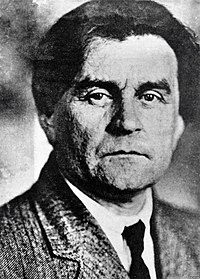Kazimir Malevich
| Kazimir Malevich | |
|---|---|

Photograph of Malevich
|
|
| Born |
Kazimir Severinovich Malevich Russian: Казими́р Севери́нович Мале́вич 23 February 1878 Kiev Governorate of Russian Empire, now Ukraine |
| Died | 15 May 1935 (aged 57) Leningrad, Soviet Union |
| Nationality | Russian Empire then Soviet Union |
| Education | Moscow School of Painting, Sculpture, and Architecture |
| Known for | Painting |
| Notable work | Black Square, 1915; White On White, 1918 |
| Movement | Suprematism |
| Ethnicity | Polish |
Kazimir Severinovich Malevich (February 23, 1878 – May 15, 1935) was a Russian painter and art . He was a pioneer of geometric abstract art and the originator of the avant-garde Suprematist movement. He was a devout Christian mystic who believed the central task of an artist was that of rendering spiritual feeling.
Kazimir Malevich was born Kazimierz Malewicz to a Polish family, who settled near Kiev in Kiev Governorate of the Russian Empire during the partitions of Poland. His parents, Ludwika and Seweryn Malewicz, were Roman Catholic like most ethnic Poles, though his father attended Orthodox services as well. They both had fled from the former eastern territories of the Commonwealth (present-day Kopyl Region of Belarus) to Kiev in the aftermath of the failed Polish January Uprising of 1863 against the tsarist army. His native language was Polish though he spoke Ukrainian in public. Subsequently, Malevich even wrote a series of articles about art in Ukrainian.
Kazimir's father managed a sugar factory. Kazimir was the first of fourteen children, only nine of whom survived into adulthood. His family moved often and he spent most of his childhood in the villages of Ukraine, amidst sugar-beet plantations, far from centers of culture. Until age twelve he knew nothing of professional artists, although art had surrounded him in childhood. He delighted in peasant embroidery, and in decorated walls and stoves. He was able to paint in the peasant style. He studied drawing in Kiev from 1895 to 1896.
From 1896 to 1904 Kazimir Malevich lived in Kursk. In 1904, after the death of his father, he moved to Moscow. He studied at the Moscow School of Painting, Sculpture, and Architecture from 1904 to 1910 and in the studio of Fedor Rerberg in Moscow (1904 to 1910). In 1911 he participated in the second exhibition of the group, Soyuz Molodyozhi (Union of Youth) in St. Petersburg, together with Vladimir Tatlin and, in 1912, the group held its third exhibition, which included works by Aleksandra Ekster, Tatlin, and others. In the same year he participated in an exhibition by the collective, Donkey's Tail in Moscow. By that time his works were influenced by Natalia Goncharova and Mikhail Larionov, Russian avant-garde painters, who were particularly interested in Russian folk art called lubok. Malevich described himself as painting in a "Cubo-Futuristic" style in 1912. In March 1913 a major exhibition of Aristarkh Lentulov's paintings opened in Moscow. The effect of this exhibition was comparable with that of Paul Cézanne in Paris in 1907, as all the main Russian avant-garde artists of the time (including Malevich) immediately absorbed the cubist principles and began using them in their works. Already in the same year the Cubo-Futurist opera, Victory Over the Sun, with Malevich's stage-set, became a great success. In 1914 Malevich exhibited his works in the Salon des Indépendants in Paris together with Alexander Archipenko, Sonia Delaunay, Aleksandra Ekster, and Vadim Meller, among others. Malevich also co-illustrated, with Pavel Filonov, Selected Poems with Postscript, 1907–1914 by Velimir Khlebnikov and another work by Khlebnikov in 1914 titled Roar! Gauntlets, 1908–1914, with Vladimir Burliuk.
...
Wikipedia
